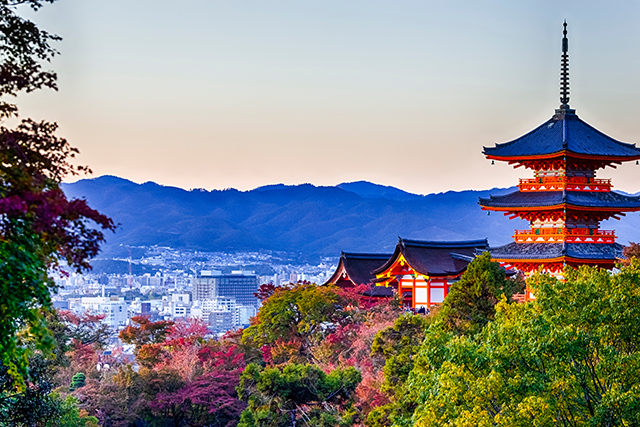Kyoto truly appeals to everyone, and with the opening up of new hotels, unique venues and a fund to promote its sustainable future, the city is becoming even more attractive as a business events destination
Brought to you by Kyoto Convention & Visitors Bureau

EXCITING STAYS
The Higashiyama district along the slopes of Kyoto’s eastern mountain range is one of the city’s best preserved historic districts, home to numerous World Heritage Sites and Important Cultural Properties. For visitors keen to experience exceptional Kyoto accommodation in this iconic area, there are several new hotels rich in history and comfort with excellent access to the sights.

One such hotel is The Hotel Seiryu Kyoto Kiyomizu, which opened in March 2020 and was converted from a historic schoolhouse, retaining much of the building’s characteristics. It features 48 guestrooms, spacious gardens and rooftops, a restaurant that focuses on local ingredients (suitable for up to 44 pax), a guest lounge (maximum 30 pax), a fitness gym and three private baths. Guests can enjoy views of Yasaka Pagoda from the guest lounge or skip over to 1,200-year-old Kiyomizu-dera Temple which stands just an eight-minute walk away.

The Gate Hotel Kyoto Takasegawa by Hulic also opened recently in July 2020. It is located by the Takase River and comprises the Main building, which has modern rooms in six distinct styles (The Gate, Classy, Scenic, Essential, Modest and Cinema) and the Schoolhouse building, which retains features from its former existence as an elementary school such as its high ceilings and spacious windows. The restaurant serves seasonal cuisine with views of verdant Higashiyama. The surroundings are steeped in history, with the Kyoto residences of many feudal domains formerly located here, and the historic alley of Pontocho is only a three-minute walk away.
REMARKABLE VENUES
Kyoto has 46 unique venues spread across the city, in six categories: World Heritage Sites; temples and shrines; museums and tourist attractions; historical buildings; restaurants and event spaces; and chartered trains. While all spectacular in their own way, here are some outstanding options for events with attendees new to Kyoto.

Nijo-jo Castle was first built in 1603 by Tokugawa Ieyasu, the first shogun of the Edo shogunate, to protect the emperor in the Kyoto Imperial Palace and to serve as the shogun’s residence during his visits to Kyoto. It was registered as a World Heritage Site in 1994 and makes a grand venue for receptions. Guests can appreciate the castle’s original glory, including the magnificent Kara-mon Gate (a designated Important Cultural Property), which can accommodate up to 400 pax (theater style or buffet style) in the front courtyard. There is also exclusive access to areas normally closed to the public. Koun-tei Tea House is suitable for up to 30 pax (seated) while the scenic Japanese Seiryu-en Garden suits up to 300 pax (theater or buffet style).

Kyoto City KYOCERA Museum of Art is the oldest public art museum building in Japan. Built in a “Crown Imperial Style” that blends Japanese and Western features, the building is considered a work of art and was refurbished in 2020. The open-air inner courtyard, which was previously closed to the public, has been reborn as an atrium-style space with a glass roof, making it a unique venue perfect for parties welcoming special guests and more.

Similarly, the Kyoto National Museum, which opened in 1897, can be used for stunning receptions in the Grand Lobby (200 buffet, 140 seated), Tea House Tan’an (10 seated) and the garden (300 buffet, 210 seated). The museum building is characterised by a fusion of ancient and modern, with the red brick Important Cultural Property Meiji Kotokan Hall standing alongside the 2014-built Heisei Chishikan Wing that incorporates Japanese motifs throughout.

The Old Mitsui Family Shimogamo Villa is a beautifully preserved example of modern Japanese architecture. The three-story building is surrounded by greenery and blends in magnificently with the moss garden and pond. Guests can enjoy a Japanese lunch (up to 24 pax) and take a break in the gardens while sipping on matcha. The drawing room can accommodate 16 pax (classroom style) to 30 pax (theater style).
All capacities reflect use under non-pandemic conditions.
TOP SUPPORT
As an international centre of history and culture, Kyoto has launched a MICE Fund to preserve its rich heritage for future generations. It aims to also enhance the attractiveness of the city, improve lives, promote business events and tourism, and contribute to the Sustainable Development Goals.

According to Yoshiaki Matsui, deputy director of the Bidding and Promotion Division/Event Support Division of the Department of Conventions and Tourism, the MICE Fund is the first of its kind in Japan to collect donations from participants of international conferences and corporate meetings, organisers, and companies. Contributions go towards making Kyoto’s tangible and intangible culture, nature, and lifestyle sustainable. Initiatives to receive support are chosen regularly by a committee to ensure local organisations, facilities and properties receive the support they need, including help recovering from the impact of the Covid-19 pandemic and natural disasters.






















